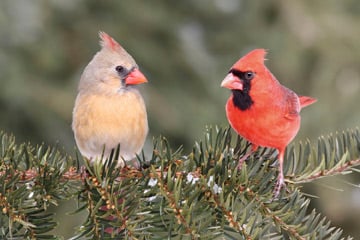National Wildlife Week is March 18-24 this year. The theme is “Branching Out for Wildlife,” with a focus on how wildlife depend upon trees for survival. Pictured: A pair of Northern Cardinals on a tree branch. Credit:iStockPhoto
EarthTalk®
E – The Environmental Magazine
Dear EarthTalk: What is the purpose of National Wildlife Week, which I understand will take place in March 2013? — Melissa P., Burlington, NJ
National Wildlife Week is a program of the non-profit National Wildlife Federation (NWF) that is designed around teaching and connecting kids to the wonders of wildlife. Each year, the group picks a theme and provides fun and informative educational materials, curriculum and activities for educators and caregivers to use with their kids.
This coming March 18-24 (2013), the theme of National Wildlife Week is “Branching Out for Wildlife” with a focus on trees. Participating kids will learn about the parts of a tree, the role of trees and how wildlife depend on trees for survival. They can also participate in environmental service projects addressing climate change, healthy habitats, reforestation and connecting with the environment.
Teachers, instructors, coaches and parents can sign up with NWF and get a wide range of free resources—lesson plans, posters, trading cards, etc.—to help spread the educational messages of National Wildlife Week into school curricula, after-school and even at-home activities.
2013 marks the 75th year NWF has run National Wildlife Week, making it the group’s longest running educational program. To mark the milestone anniversary, NWF has adopted the goal of planting 75,000 trees across the country. School and youth groups can apply to host a tree planting event with NWF, which will provide native trees adapted to the local climate, as well as tree guards, shovels, mulch, watering supplies and gloves.
Beyond National Wildlife Week, all year long NWF will feature detailed information on their website about different types of wildlife that live in or are dependent upon trees across the country. Young people are encouraged to stay on the lookout for wildlife near them throughout National Wildlife Week and log their sightings accordingly—and can share them online via NWF’s interactive Wildlife Watch Map.
The Branching Out for Wildlife Mega-Poster is comprised of smaller sections that each graphically display the different parts of a tree—roots and soil, forest floor, trunk, branches and leaves/fruit/flowers—and the wildlife that frequent them. At five and a half feet tall, the complete mega-poster is a real attention grabber in any room. Anyone can print out the sections for free as they are all available via the NWF website as PDF downloads.
Wildlife Week is not the only way NWF educates kids and inspires a lifelong love of nature. The group has worked with teachers for decades to get kids learning outdoors. Recently NWF launched a campaign to get 10 million more American children out of their indoor habitats and into the great outdoors over the next three years. And its Eco-Schools USA and Schoolyard Habitats programs harness the power of teachers and students to green thousands of K-12 schools across the country. And the group’s Earth Tomorrow campaign is a multi-cultural youth environmental program that creates opportunities for underserved youth to learn about their world and contribute to the ecological health of their communities.
CONTACT: NWF National Wildlife Week, www.nwf.org/national-wildlife-week.aspx.
EarthTalk® is written and edited by Roddy Scheer and Doug Moss and is a registered trademark of E – The Environmental Magazine (www.emagazine.com). Send questions to: [email protected]. Subscribe: www.emagazine.com/subscribe. Free Trial Issue: www.emagazine.com/trial.








